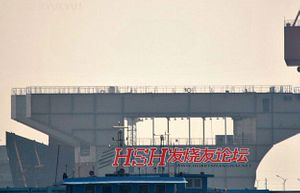Recently reports have surfaced that China is beginning construction on a second aircraft carrier. Beijing’s current flattop, the Liaoning, was molded out of an abandon Soviet hull that has quite a history. If reports, which are based on pictures (see to the left) posted in Chinese military forums, are accurate, China's newest vessel will be the first domestically designed carrier — an important milestone.
Truth be told, such a move has long been expected. Over the last several decades China has purchased various decommissioned carriers in an apparent attempt to understand the complex engineering and technological aspects needed to master this important floating symbol of power. Indeed, various reports have circulated for the last several years that such carriers were in the offing.
While such news is important, the vessel is a decade or so from being a true factor in Asia’s security scene. The pictures that are circulating online also seem to raise more questions than answers. Will the carrier be powered conventionally or by nuclear means? How many jets will it carry? Will such jets be stealthy 5th generation fighters? Is there a third carrier being built…and so on.
Indeed, while Beijing’s anti-access capabilities get quite the buzz, China has slowly amassed the naval assets necessary to build a so-called “blue-water navy.”
While a confluence of factors would need to emerge for the creation of such a force, the trend lines clearly point to a Chinese Navy (or the People's Liberation Army Navy, or PLAN) that is ever capable, better trained, and technologically ready for the challenges ahead.
Looking back at the past decade one gets the sense that China is increasingly looking to the seas to not only project power but protect its vital interests. While for most of its history a continental power, as tensions with the then Soviet Union and now Russia have eased, China has shifted its defense priorities from a possible land or nuclear war with Moscow to conflict in the near seas out to what is called the first-island chain. Through foreign acquisitions, investments in domestic shipbuilding, R&D and training, Beijing is developing a Navy that is increasingly world-class and poised to join the ranks of the world's finest fleets.
China has in fact slowly begun to flex its sea legs and demonstrate its growing capabilities not just in home waters, but also globally. Beijing has conducted a number of large scale training operations with regional partners that clearly demonstrate its increasing potential. It has conducted multiple anti-piracy operations along with others in the Gulf of Aden. China also sent a guided missile destroyer to Libya to assist in rescue operations of Chinese nationals back in 2011, and conducted cruises into far flung places such as the Black Sea.
While the overall trend of Chinese sea power is one of increasing regional capabilities and a slowly growing footprint into other parts of the world, clearly challenges remain. Chinese naval planners in the coming decades will face a number of key challenges that will shape the strategy, procurement, capabilities and character of the force.
One key question is the issue of financial resources. Beijing's naval rise has benefited from an economy growing at breakneck speed, which has allowed Chinese leaders to appropriate double-digit annual defense budget increases. As China's economy has slowed over the last several quarters, Beijing may find itself under increasing pressure to shift important financial resources to domestic programs that reform China's economy into a more consumption driven and ultimately sustainable model. While 21st century naval assets are important considering the present geostrategic environment in East Asia and the greater Indo-Pacific, a strong and vibrant Chinese economy does more in the long-term for China’s regional and indeed global aspirations, as well as the continued rule of the CCP.
There are also long-term regional factors that must be evaluated. While Russia today is considered a regional partner and not a threat to China's borders, history shows that the situation can change rapidly. Beijing has been able to pour tremendous resources into its naval assets in part because Sino-Russian relations have transformed in recent decades.
It was therefore no surprise that Chinese President Xi Jinping traveled to Moscow for his first foreign trip as China’s top leader. Beijing's great technological leap-forward in military technology is in many respects attributable to its acquisitions of Russian military equipment — with rumors of more to come. Yet, considering the historical rivalry between these two great powers and recent Russian military maneuvers that some believe were aimed in part at Beijing, one can only wonder if such an arrangement is more a marriage of convenience instead of a true strategic partnership.
So long as U.S.-Russian relations remain strained over the ongoing Edward Snowden drama, missile defense and other issues, Moscow has clear strategic reasons to seek a warmer relationship with Beijing. However, there is no guarantee such a partnership is viable over the long-term. If relations were to sour at some point, China would need to pour greater resources into its land and nuclear assets, naturally taking vital resources away from its naval rise.
In the future, we will likely see China's armed forces reach many important milestones. Clearly, China's economy, now the world's second largest, has given its armed forces and particular its Navy the resources it needs to match its growing aspirations. In fact, China's new carrier is the perfect example when considering the current state of China's navy — full of growing capabilities but incomplete with clear challenges ahead.
































